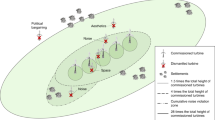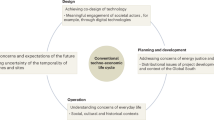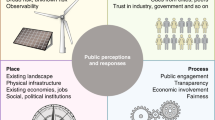Abstract
Studies on social acceptance of wind power projects typically evaluate wind power in isolation, or as a choice between wind and no wind. However, at a societal level, the choice is not limited to whether, how or where wind turbines should be sited, but whether society should generate electricity by wind or from some other source. Consequently, it is important to understand whether those living near local wind projects prefer them relative to other local power projects. Here, we show that approximately 90% of individuals in the United States who live within 8 km of a wind turbine prefer their local wind project to a centralized power plant sited a similar distance away. Wind is also preferred three to one over solar among the approximately two-thirds who have a preference. These results are relatively consistent across states with different characteristics, suggesting a strong social preference for wind turbines among their neighbours.
This is a preview of subscription content, access via your institution
Access options
Access Nature and 54 other Nature Portfolio journals
Get Nature+, our best-value online-access subscription
$29.99 / 30 days
cancel any time
Subscribe to this journal
Receive 12 digital issues and online access to articles
$119.00 per year
only $9.92 per issue
Buy this article
- Purchase on Springer Link
- Instant access to full article PDF
Prices may be subject to local taxes which are calculated during checkout


Similar content being viewed by others
Data availability
A copy of the survey and codebook for the database is available at https://emp.lbl.gov/projects/wind-neighbor-survey. A de-identified version of the basic database is available upon reasonable request from the Lawrence Berkeley National Laboratory, with extensions available from the corresponding author upon approval to ensure proper handling of human subjects data.
References
O’Connor, P. A. & Cleveland, C. J. U.S. energy transitions 1780–2010. Energy 7, 7955–7993 (2014).
Bridge, G., Bouzarovski, S., Bradshaw, M. & Eyre, N. Geographies of energy transition: space, place and the low-carbon economy. Energy Policy 53, 331–340 (2013).
2017 Wind Technologies Market Report (US Department of Energy, 2018); https://www.energy.gov/eere/wind/downloads/2017-wind-technologies-market-report
Utility-Scale Solar: Empirical Trends in Project Technology, Cost, Performance, and PPA Pricing in the United States—2018 Edition (Lawrence Berkeley National Laboratory, 2018); http://eta-publications.lbl.gov/sites/default/files/lbnl_utility_scale_solar_2018_edition_report.pdf
Carley, S. State renewable energy electricity policies: an empirical evaluation of effectiveness. Energy Policy 37, 3071–3081 (2009).
Bird, L. et al. Policies and market factors driving wind power development in the United States. Energy Policy 33, 1397–1407 (2005).
Butler, C., Parkhill, K. A. & Pidgeon, N. F. Nuclear power after Japan: the social dimensions. Environ. Sci. Policy Sustain. Dev. 53, 3–14 (2011).
Lucas, H. C. & Goh, J. M. Disruptive technology: how Kodak missed the digital photography revolution. J. Strategic Inf. Syst. 18, 46–55 (2009).
Kaufman, N. & Krause, E. Putting a Price on Carbon: Ensuring Equity (World Resources Institute, 2016); https://www.wri.org/publication/putting-price-carbon-ensuring-equity
Archer, C. L., Mirzaeisefat, S. & Lee, S. Quantifying the sensitivity of wind farm performance to array layout options using large-eddy simulation. Geophys. Res. Lett. 40, 4963–4970 (2013).
Wolsink., M. Co-production in distributed generation: renewable energy and creating space for fitting infrastructure within landscapes. Landsc. Res. 43, 542–561 (2018).
Pasqualetti, M. J. Opposing wind energy landscapes: a search for common cause. Ann. Assoc. Am. Geogr. 101, 907–917 (2011).
Thayer, R. L. & Freeman, C. M. Altamont: public perceptions of a wind energy landscape. Landsc. Urban Plan. 14, 379–398 (1987).
Wolsink, M. Social acceptance revisited: gaps, questionable trends, and an auspicious perspective. Energy Res. Soc. Sci. 46, 287–295 (2018).
Gaede, J. & Rowlands, I. H. Visualizing social acceptance research: a bibliometric review of the social acceptance literature for energy technology and fuels. Energy Res. Soc. Sci. 40, 142–158 (2018).
Rand, J. & Hoen, B. Thirty years of North American wind energy acceptance research: what have we learned? Energy Res. Soc. Sci. 29, 135–148 (2017).
Ellis, G. & Ferraro, G. The Social Acceptance of Wind Energy: Where we Stand and the Path Ahead—Study (Joint Research Centre, 2016); https://doi.org/10.2789/696070
Wüstenhagen, R., Wolsink, M. & Bürer, M. J. Social acceptance of renewable energy innovation: an introduction to the concept. Energy Policy 35, 2683–2691 (2007).
Van Veelen, B. & Haggett, C. Uncommon ground: the role of different place attachments in explaining community renewable energy projects. Sociol. Ruralis 57, 533–554 (2016).
Devine-Wright, P. Rethinking NIMBYism: the role of place attachment and place identity in explaining place-protective action. J. Commun. Appl. Soc. Psychol. 19, 426–441 (2009).
Firestone, J. et al. Reconsidering barriers to wind power projects: community engagement, developer transparency and place. J. Environ. Policy Plan. 20, 370–386 (2018).
Bidwell, D. Thinking through participation in renewable energy decisions. Nat. Energy 1, 16051 (2016).
Wolsink, M. Planning of renewables schemes: deliberative and fair decision-making on landscape issues instead of reproachful accusations of non-cooperation. Energy Policy 35, 2692–2704 (2007).
Sonnberger, M. & Ruddat, M. Disclosing citizens’ perceptual patterns of the transition to renewable energy in Germany. Nat. Cult. 13, 253–280 (2018).
Bell, D., Gray, T. & Haggett, C. The ‘social gap’ in wind farm siting decisions: explanations and policy responses. Environ. Polit. 14, 460–477 (2005).
Musall, F. D. & Kuik, O. Local acceptance of renewable energy—a case study from southeast Germany. Energy Policy 39, 3252–3260 (2011).
Schweizer-Ries, P. Energy sustainable communities: environmental psychological investigations. Energy Policy 36, 4126–4135 (2008).
Fast, S. et al. Lessons learned from Ontario wind energy disputes. Nat. Energy 1, 15028 (2016).
Cowell, R., Bristow, G. & Munday, M. Acceptance, acceptability and environmental justice: the role of community benefits in wind energy development. J. Environ. Plan. Manage. 54, 539–557 (2011).
Hoen, B. et al. Spatial hedonic analysis of the effects of US wind energy facilities on surrounding property values. J. Real Estate Finance Econ. 51, 22–51 (2015).
Levy, J. I. et al. Carbon reductions and health co-benefits from US residential energy efficiency measures. Environ. Res. Lett. 11, 034017 (2016).
Hidden Costs of Energy: Unpriced Consequences of Energy Production and Use (National Academies, 2010); https://www.nap.edu/catalog/12794/hidden-costs-of-energy-unpriced-consequences-of-energy-production-and
Turconi, R., Boldrin, A. & Astrup, T. Life cycle assessment (LCA) of electricity generation technologies: overview, comparability and limitations. Renew. Sustain. Energy Rev. 28, 555–565 (2013).
Demski, C., Butler, C., Parkhill, K. A., Spence, A. & Pidgeon, N. F. Public values for energy system change. Glob. Environ. Change 34, 59–69 (2015).
Ansolabehere, S. & Konisky, D. M. Public attitudes toward construction of new power plants. Public Opin. Q. 73, 566–577 (2009).
Slovic, P., Peters, E., Finucane, M. L. & MacGregor, D. G. Affect, risk, and decision making. Health Psychol. 24, S35–S40 (2005).
Truelove, H. B. Energy source perceptions and policy support: image associations, emotional evaluations, and cognitive beliefs. Energy Policy 45, 478–489 (2012).
Jenkins, K., McCauley, D., Heffron, R., Stephan, H. & Rehner, R. Energy justice: a conceptual review. Energy Res. Soc. Sci. 11, 174–182 (2016).
Millstein, D., Wiser, R., Bolinger, M. & Barbose, G. The climate and air-quality benefits of wind and solar power in the United States. Nat. Energy 2, 17134 (2017).
Levy, J. L. & Spengler, J. D. Modeling the benefits of power plant emission controls in Massachusetts. J. Air Waste Manage. Assoc. 52, 5–18 (2002).
Weiss, E. B. In Fairness to Future Generations: International Law, Common Patrimony, and Intergenerational Equity (Transnational Publishers & United Nations Univ., 1989).
Greenberg, M. Energy sources, public policy, and public preferences: analysis of US national and site-specific data. Energy Policy 37, 3242–3249 (2009).
Greenberg, M. & Truelove, H. B. Energy choices and risk beliefs: is it just global warming and fear of a nuclear power plant accident? Risk Anal. 31, 819–831 (2011).
Devine-Wright, P., Devine-Wright, H. & Cowell, R. What do we Know About Overcoming Barriers to Infrastructure Sitting in Local Areas? (Department of Energy and Climate Change, 2016); http://www.placewise.org/wp-content/uploads/2016/03/DECC_Infrastructure_PlacewiseLtd.pdf
Aitken, M. Wind power and community benefits: challenges and opportunities. Energy Policy 38, 6066–6075 (2010).
Bates, A. & Firestone, J. A comparative assessment of offshore wind power demonstration projects in the United States. Energy Res. Soc. Sci. 10, 192–205 (2015).
Carlisle, J. E., Solan, D., Kane, S. L. & Joe, J. Utility-scale solar and public attitudes toward siting: a critical examination of proximity. Land Use Policy 58, 491–501 (2016).
Moore, S. & Hackett, E. J. The construction of technology and place: concentrating solar power conflicts in the United States. Energy Res. Soc. Sci. 11, 67–78 (2016).
Firestone, J., Kempton, W. & Krueger, A. Public acceptance of offshore wind power projects in the United States. Wind Energy 12, 183–202 (2009).
The United States Wind Turbine Database (United States Geological Survey, Lawrence Berkeley National Laboratory, and American Wind Energy Association, 2015); https://eerscmap.usgs.gov/uswtdb/data/
Dillman, D. A., Smyth J. D. & Christian, L. M. Internet, Mail and Mixed Mode Surveys: The Tailored Design Method 4th edn (John Wiley & Sons, 2014).
Batel, S., Devine-Wright, P. & Tangeland, T. Social acceptance of low carbon energy and associated infrastructures: a critical discussion. Energy Policy 58, 1–5 (2013).
Decennial Census of the Population and Housing (US Census Bureau, 2010); https://www.census.gov/programs-surveys/decennial-census/data/datasets.2010.html
What is Rural? (US Department of Agriculture, 2016); https://www.nal.usda.gov/ric/what-is-rural
Farms and Land in Farms 2017 release (US Department of Agriculture, 2018); https://usda.library.cornell.edu/concern/publications/5712m6524?locale=en
Vincent, C. H., Hanson, L. A. & Argueta, C. N. Federal Land Ownership: Overview and Data Report R42346 (Congressional Research Service, 2017); https://fas.org/sgp/crs/misc/R42346.pdf
Summary Report: 2015 National Resources Inventory (US Department of Agriculture, 2018); https://www.nrcs.usda.gov/wps/portal/nrcs/main/national/technical/nra/nri/
Direct Normal Solar Irradiance 1998–2016 Maps (National Renewal Energy Laboratory, 2016);https://www.nrel.gov/gis/assets/pdfs/solar_dni_2018_01.pdf
Frequently asked questions: which states produce the most coal? US Energy Information Administration https://www.eia.gov/tools/faqs/faq.php?id=69&t=2 (2018).
Electric Power Annual 2017 (US Energy Information Administration, 2018); https://www.eia.gov/electricity/annual/
Historical election results. National Archives and Records Administration https://www.archives.gov/federal-register/electoral-college/historical.html (2018).
Solon, G., Haider, S. J. & Wooldridge, J. M. What are we weighting for? J. Hum. Resour. 50, 301–316 (2015).
Tiebout, C. A pure theory of local expenditures. J. Polit. Econ. 64, 416–424 (1956).
Acknowledgements
The authors thank the United States Department of Energy’s Lawrence Berkeley National Laboratory for making the dataset publicly available, and the researchers on that project (in particular, the project investigator B. Hoen) for undertaking the survey and preparing the dataset.
Author information
Authors and Affiliations
Contributions
J.F. devised the research question, gathered additional data, performed statistical analysis and interpretation of the data, and wrote the initial draft of the manuscript. H.K. performed statistical analysis, reviewed, commented on and edited the manuscript, and prepared draft figures.
Corresponding author
Ethics declarations
Competing interests
J.F. has held various roles related to a 2-MW wind turbine adjacent to the University of Delaware’s coastal campus since its commissioning in 2010, and has been a director of the legal entity First State Marine Wind, which has owned and operated the wind turbine since 2016. The University of Delaware has majority control of First State Marine Wind; Siemens Gamesa, the manufacturer, is the minority partner. The turbine provides electricity to the University of Delaware campus and to Lewes, Delaware. Net proceeds are used for research and graduate fellowships. He has held these positions at the desire of his employer, the University of Delaware, and receives no compensation beyond his regular university salary for this service.
Additional information
Publisher’s note: Springer Nature remains neutral with regard to jurisdictional claims in published maps and institutional affiliations.
Supplementary information
Supplementary Information
Supplementary Tables 1–2
Rights and permissions
About this article
Cite this article
Firestone, J., Kirk, H. A strong relative preference for wind turbines in the United States among those who live near them. Nat Energy 4, 311–320 (2019). https://doi.org/10.1038/s41560-019-0347-9
Received:
Accepted:
Published:
Issue Date:
DOI: https://doi.org/10.1038/s41560-019-0347-9
This article is cited by
-
Understanding supply-side climate policies: towards an interdisciplinary framework
International Environmental Agreements: Politics, Law and Economics (2024)
-
Development of onshore wind turbine fleet counteracts climate change-induced reduction in global capacity factor
Nature Energy (2022)
-
Scenicness assessment of onshore wind sites with geotagged photographs and impacts on approval and cost-efficiency
Nature Energy (2021)
-
A continuously updated, geospatially rectified database of utility-scale wind turbines in the United States
Scientific Data (2020)
-
Choosing the lesser of two evils?
Nature Energy (2019)



